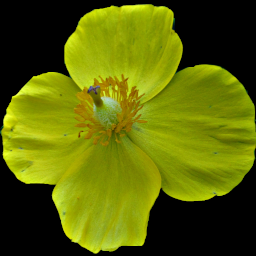 A European plant often cultivated here as a ground cover, but increasingly escaping into the wild. This plant was growing deep in the woods in Fox Chapel, on a hillside overlooking the Squaw Run, far from any cultivated planting. It is also commonly placed in the genus Lamiastrum, or “False Lamium.” So it is classified in the USDA PLANTS database, which records it as found in the wild in Pennsylvania. This particular plant, which shows the variegated leaves often found in cultivated varieties, was blooming in early May.
A European plant often cultivated here as a ground cover, but increasingly escaping into the wild. This plant was growing deep in the woods in Fox Chapel, on a hillside overlooking the Squaw Run, far from any cultivated planting. It is also commonly placed in the genus Lamiastrum, or “False Lamium.” So it is classified in the USDA PLANTS database, which records it as found in the wild in Pennsylvania. This particular plant, which shows the variegated leaves often found in cultivated varieties, was blooming in early May.
Gray describes the genus Lamium thus:
LAMIUM L. DEAD NETTLE. Calyx tubular-bell-shaped, about 5-nerved, with 5 nearly equal awl-pointed teeth. Corolla dilated at the throat; upper lip ovate or oblong, arched, narrowed at the base; the middle lobe of the spreading lower lip broad, notched at the apex, contracted as if stalked at the base; the lateral ones small, at the margin of the throat. Decumbent herbs, the lowest leaves small and long-petioled, the middle heart-shaped and doubly toothed, the floral subtending the whorled flower-cluster. (Name from lamos, throat, in allusion to the ringent corolla.)
This species is not described in the standard American botanical references, so we borrow a very thorough description from English Botany by James Sowerby.
LAMIUM GALEOBDOLON. Crantz.
Galeobdolon luteum, Ends. Sm. Engl. Bot. ed. i. No. 787. Koch, Syn. Fl. Germ. et Helv. ed. ii. p. 650. Galeopsis Galeobdolon, Linn. Sp. Pl. p. 810.
Perennial. Rootstock tufted or very shortly creeping. Barren shoots very long, trailing or arching, at length rooting. Flowering stems not rooting at the base, erect or ascending. Leaves stalked, ovate or deltoid-ovate, subcordate, slightly acuminate, acute, doubly or irregularly crenate-serrate. Verticillasters remote from each other. Lower bracts similar to the leaves, but narrower, and with shorter stalks; upper ones generally lanceolate, with a wedge-shaped base, more rarely similar to the lower ones. Calyx puberulent or sparingly bristly-hairy; teeth deltoid, abruptly acuminated into triangular points, sparingly ciliated or glabrous, and subspinous at the apex, spreading, not half the length of the tube; tube slightly curved and oblique at the mouth. Corolla tube rather longer than the calyx, with a conspicuous very oblique ring of hairs within, slightly curved upwards, without a projecting sac near the base on the lower side, suddenly enlarged towards the apex; upper hp greatly vaulted, obtuse, sparingly hairy; lower lip with the lateral lobes ovate-acuminate, the middle lobe a little larger, oblong, acuminated into a lanceolate point.
In woods and on hedge-banks, particularly on chalk and limestone formations. Local, but not uncommon in the south of England; rare in the north, where it extends north to Lancashire and Yorkshire. It has occurred in Scotland, but is scarcely deserving to be considered even as a naturalised plant. Rare, and very local in Ireland, where it is nearly confined to the east of the island.
England, [Scotland,] Ireland. Perennial. Spring, early Summer.
Rootstock many-headed, emitting numerous wiry radical fibres and producing flowering and barren stems, the latter in autumn attaining the length of 1 or 2 feet, and growing much in the same way as those of Vinca major. Flowering stems 9 inches to 2 feet high, more or less flexuous towards the base. Lamina of the leaves 1 to 2½ inches long. Verticillasters 6 to 10 flowered. Bracts 1½ to 3 inches long, the upper ones sometimes very narrow. Calyx yellowish-green. Corolla ¾ to 1 inch long, yellow, the lower lip bright yellow, with reddish-brown s pots and streaks; upper lip considerably more than half the length of the corolla; tube very short. Anthers destitute of the hairs which occur in all the other British species. Nucules generally abortive: at least I have never been able to find them mature. Plant light green, more or less thickly pubescent with rather stiff hairs, those on the stem deflexed.
The British plant has the upper bracts usually narrow, and is the Galeobdolon montanum of Reichenbach. Occasionally, however, I have seen the bracts all broad and similar to the leaves (G. luteum, Reich.), but the two forms certainly do not deserve to be called even varieties.
Yellow Archangel.
French, Lamier jaune. German, Goldnessel.






